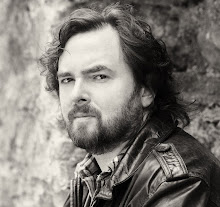So I got published today. Which is nice.
To be honest, today was a little bit like birthdays are when you get past thirty. It's a day much like any other, but you know there's a milestone at the back of your mind, that today isn't really like other days. But you still have cornflakes for breakfast, and you still get annoyed cos your internet isn't fast enough, and so on. My epiphany moment was last Friday when I first saw the books on the shelf at my local Eason's, so in my mind, publication day was really last week.
Anyway, on to a small bit of housekeeping...
During yesterday evening's interview on Radio Ulster, and at my reading at Lisburn Library (which was fun, by the way), I was questioned about who the characters in THE TWELVE were based on.
The truthful answer is this: NOBODY.
THE TWELVE is a work of fiction, and no major characters are based on anyone real (see caveat below). When I said as much yesterday and today, the questioners scoffed somewhat, said that obviously, this character was based on (insert name of prominent public figure here).
No they weren't.
I did base some of the characters on archetypes. There are certain
kinds of people that exist in Northern Ireland, and I did use those broad groups as the basis for some characters.
For instance, there's a lawyer who makes his money defending people he knows to be guilty, but publicly describes himself as a "human rights lawyer". There are many lawyers here who do just that. The character is based on them collectively, and not any one individual. Just because a reader makes a comparison between the portrayed archetype and someone they know who fits that archetype, doesn't mean the character is based on them.
Another example is a British politician. On the page, he performs two roles: one, to frame the events of the book in a wider political context, and two, to provide some comic relief from the relentless darkness throughout the rest of the book. He regards his administrative role in Northern Ireland as a poison chalice, the job that no one else wants. He is an archetype, and one every citizen of Northern Ireland will recognise in every Secretary of State we've ever had. But he is not based on any of them (he's not even the Secretary, but rather his assistant), even though people are jumping to conclusions.
Likewise, there's a character who is based on the archetypal rural gangster. There are many such people who make their money in similar ways and live in similar places. The character portrayed is an archetype. Again, just because there's someone you're aware of that fits that mould, it doesn't mean the character is based on them. There are dozens, if not hundreds, of people who could match that archetype. The character in the book is not based on a single one of them.
So there.
I guess the lesson in all this is that readers will bring their own preconceptions to a piece of fiction; they'll see the things that they want to see in it. For instance, I am constantly surprised that some readers are quite adamant that Gerry Fegan's spectres are merely psychological manifestations of his own guilt, while others are positive they are supernatural. Even when the book shows their true nature in the closing pages, some readers will stick to their orginal assumption - in other words, they find what they want to see reflected in this mirror, regardless of what's really there.
About that caveat...
I did base a couple of minor characters on real people. They are blink-and-you'll-miss-them roles modelled on people I actually know, but as it turned out, the people in question didn't think it was the jolly jape I thought it was. In fact, they were pretty offended. There's a lesson there too, kids...
Labels: life, people, publishing, the twelve







